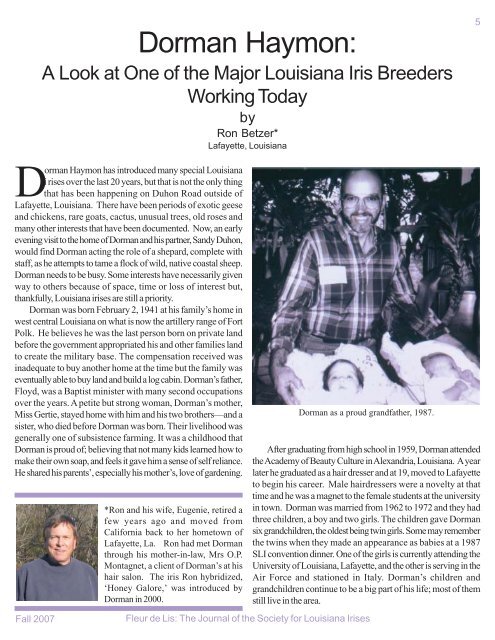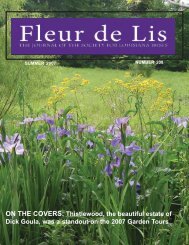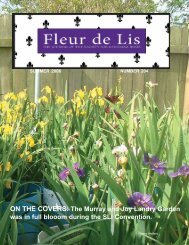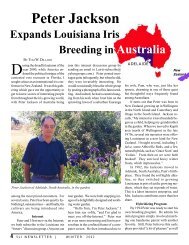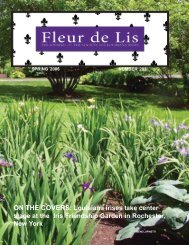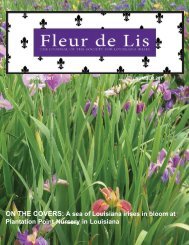Dorman Haymon - Society for Louisiana Iris
Dorman Haymon - Society for Louisiana Iris
Dorman Haymon - Society for Louisiana Iris
You also want an ePaper? Increase the reach of your titles
YUMPU automatically turns print PDFs into web optimized ePapers that Google loves.
<strong>Dorman</strong> <strong>Haymon</strong>:<br />
A Look at One of the Major <strong>Louisiana</strong> <strong>Iris</strong> Breeders<br />
Working Today<br />
by<br />
Ron Betzer*<br />
Lafayette, <strong>Louisiana</strong><br />
5<br />
<strong>Dorman</strong> <strong>Haymon</strong> has introduced many special <strong>Louisiana</strong><br />
i rises over the last 20 years, but that is not the only thing<br />
that has been happening on Duhon Road outside of<br />
Lafayette, <strong>Louisiana</strong>. There have been periods of exotic geese<br />
and chickens, rare goats, cactus, unusual trees, old roses and<br />
many other interests that have been documented. Now, an early<br />
evening visit to the home of <strong>Dorman</strong> and his partner, Sandy Duhon,<br />
would find <strong>Dorman</strong> acting the role of a shepard, complete with<br />
staff, as he attempts to tame a flock of wild, native coastal sheep.<br />
<strong>Dorman</strong> needs to be busy. Some interests have necessarily given<br />
way to others because of space, time or loss of interest but,<br />
thankfully, <strong>Louisiana</strong> irises are still a priority.<br />
<strong>Dorman</strong> was born February 2, 1941 at his family’s home in<br />
west central <strong>Louisiana</strong> on what is now the artillery range of Fort<br />
Polk. He believes he was the last person born on private land<br />
be<strong>for</strong>e the government appropriated his and other families land<br />
to create the military base. The compensation received was<br />
inadequate to buy another home at the time but the family was<br />
eventually able to buy land and build a log cabin. <strong>Dorman</strong>’s father,<br />
Floyd, was a Baptist minister with many second occupations<br />
over the years. A petite but strong woman, <strong>Dorman</strong>’s mother,<br />
Miss Gertie, stayed home with him and his two brothers—and a<br />
sister, who died be<strong>for</strong>e <strong>Dorman</strong> was born. Their livelihood was<br />
generally one of subsistence farming. It was a childhood that<br />
<strong>Dorman</strong> is proud of; believing that not many kids learned how to<br />
make their own soap, and feels it gave him a sense of self reliance.<br />
He shared his parents’, especially his mother’s, love of gardening.<br />
Fall 2007<br />
*Ron and his wife, Eugenie, retired a<br />
few years ago and moved from<br />
Cali<strong>for</strong>nia back to her hometown of<br />
Lafayette, La. Ron had met <strong>Dorman</strong><br />
through his mother-in-law, Mrs O.P.<br />
Montagnet, a client of <strong>Dorman</strong>’s at his<br />
hair salon. The iris Ron hybridized,<br />
‘Honey Galore,’ was introduced by<br />
<strong>Dorman</strong> in 2000.<br />
<strong>Dorman</strong> as a proud grandfather, 1987.<br />
After graduating from high school in 1959, <strong>Dorman</strong> attended<br />
the Academy of Beauty Culture in Alexandria, <strong>Louisiana</strong>. A year<br />
later he graduated as a hair dresser and at 19, moved to Lafayette<br />
to begin his career. Male hairdressers were a novelty at that<br />
time and he was a magnet to the female students at the university<br />
in town. <strong>Dorman</strong> was married from 1962 to 1972 and they had<br />
three children, a boy and two girls. The children gave <strong>Dorman</strong><br />
six grandchildren, the oldest being twin girls. Some may remember<br />
the twins when they made an appearance as babies at a 1987<br />
SLI convention dinner. One of the girls is currently attending the<br />
University of <strong>Louisiana</strong>, Lafayette, and the other is serving in the<br />
Air Force and stationed in Italy. <strong>Dorman</strong>’s children and<br />
grandchildren continue to be a big part of his life; most of them<br />
still live in the area.<br />
Fleur de Lis: The Journal of the <strong>Society</strong> <strong>for</strong> <strong>Louisiana</strong> <strong>Iris</strong>es
6<br />
In 1969, <strong>Dorman</strong> bought into the<br />
salon in which he worked. A teaching<br />
school was also opened and Sandy<br />
happened to be one of the students. Sandy<br />
went on to become a partner in his own<br />
salon but eventually he and <strong>Dorman</strong> bought<br />
out the original owner in <strong>Dorman</strong>’s shop<br />
and it became known as “<strong>Dorman</strong> and<br />
Sandy’s.” Being a lively place thoughout<br />
its history has not kept the salon from<br />
becoming known to some as the “old<br />
ladies salon”– since there are still many<br />
clients who started long ago. The salon<br />
counts several three, and even a few four,<br />
generational family members in their client<br />
base.<br />
Two early non-student clients from the<br />
university were Tressie Cook and Faenelia<br />
Hicks, professors who were very active<br />
in the <strong>Society</strong> <strong>for</strong> <strong>Louisiana</strong> <strong>Iris</strong>es (SLI).<br />
Surprisingly, the subject of <strong>Louisiana</strong> irises<br />
didn’t come up until around 1978. A<br />
mention to Tressie that he had one growing<br />
in his yard (<strong>Dorman</strong> figures it was probably<br />
a native) was all that was needed <strong>for</strong> her<br />
and Faenelia to bring him a sack of named,<br />
but unlabeled, irises. Their first bloom<br />
season found a couple of them to be<br />
‘Marie Caillet’ (Conger 1963) and<br />
‘Faenelia Hicks’(Arny 1969). <strong>Dorman</strong> had<br />
been hybridizing daylilies and amaryllis and<br />
©Robert Treadway<br />
©Robert Treadway<br />
‘Bubblegum Ballerina’<br />
‘Chuck Begnaud’<br />
wanted to cross the <strong>Louisiana</strong>s but was<br />
having trouble.<br />
Not being much help themselves, the<br />
professors took <strong>Dorman</strong> to meet<br />
(Left to Right): Sandy Duhon, <strong>Dorman</strong>, Dee Lee of Texas, and Richard Sloan of Cali<strong>for</strong>nia<br />
visit a <strong>Louisiana</strong> iris garden, ca. 1990.<br />
Professor Charles Arny, the premier<br />
hybridizer of <strong>Louisiana</strong> irises of his time—<br />
and that’s right, another professor. After<br />
learning how to make a cross, <strong>Dorman</strong><br />
went home and made his first: ‘Marie<br />
Caillet’ X ‘Faenilla Hicks.’ One pod was<br />
set in 1980 (to this day, <strong>Dorman</strong> usually<br />
makes only one cross per stalk). All three<br />
seeds germinated and resulted in huge<br />
plants. A photo exists of Marie Caillet, a<br />
charter member of SLI standing next to<br />
one with it towering over her. Miss Marie,<br />
also a professor and a friend of the other<br />
professors (but not a client because she<br />
felt she could cut her curly hair as well as<br />
anyone) was most instrumental in getting<br />
<strong>Dorman</strong> to enter flowers in the local show.<br />
<strong>Dorman</strong> bought most of the irises in<br />
Arny’s catalog that first year; and <strong>for</strong> the<br />
next few years; irises became an allconsuming<br />
interest. He credits Mr. Arny<br />
with being a big influence in his early iris<br />
education and the two were to become<br />
frequent visitors in each others garden. He<br />
taught <strong>Dorman</strong> to strive <strong>for</strong> uniqueness in<br />
his plants and that any new introduction<br />
should be easily identifiable.<br />
<strong>Dorman</strong>’s thoughts on hybridization<br />
were greatly influenced by what he had<br />
learned from breeding registered cattle,<br />
another previous interest in his life. An<br />
expert cattle man had told him of the<br />
special hybrid vigor found in offspring from<br />
the cross of two concentrated but<br />
completely unrelated lines of cattle—<br />
specifically those of Europe and India.<br />
<strong>Dorman</strong> became a confirmed line-breeder<br />
(although he rarely gets closer than using<br />
half siblings) with the periodic outcross.<br />
Interestingly, <strong>Dorman</strong>’s most recent<br />
introduction ‘Suzie G’ (2007), has a direct<br />
line to <strong>Dorman</strong>’s first cross mentioned<br />
earlier.<br />
In 1988, <strong>Dorman</strong> introduced his first<br />
nine plants through Deep South Gardens,<br />
a nursery he and Sandy had founded.<br />
Two of the plants, ‘Marie Dolores’ (1988)<br />
and ‘Teresa Margaret’ (1988) were named<br />
after Mother Superiors at the Carmelite<br />
Convent in town. Through Sandy,<br />
Fleur de Lis: The Journal of the <strong>Society</strong> <strong>for</strong> <strong>Louisiana</strong> <strong>Iris</strong>es Fall 2007
7<br />
©Robert Treadway<br />
©Robert Treadway<br />
‘Empress Josephine’<br />
©Robert Treadway<br />
<strong>Dorman</strong> with a healthy clump of ‘Longue Vue,’ growing in Rodney Barton’s garden in<br />
Dallas during the 2003 SLI Convention.<br />
<strong>Dorman</strong> had become deeply involved in<br />
working with and helping the ladies of the<br />
convent. Marie Dolores, the plant, is still<br />
thought by many to be one of the best<br />
white <strong>Louisiana</strong>s on the market. A possible<br />
future introduction, to be named Aimee, is<br />
named after another nun at the Carmelite.<br />
‘Friend’s Song’<br />
As a side note, <strong>Dorman</strong> and Sandy have<br />
just recently taken a sabbatical after singing<br />
in a local church choir <strong>for</strong> over 20 years.<br />
This author has heard Sandy sing solo and<br />
can report that he has a beautiful voice—<br />
<strong>Dorman</strong> has yet to be heard.<br />
<strong>Dorman</strong>’s preference is <strong>for</strong> tall, dark<br />
and large flowered<br />
<strong>Louisiana</strong>s. Another<br />
of the plants released<br />
that first year was<br />
‘Grace Duhon’<br />
(1988). It’s a tall dark<br />
purple with a large<br />
yellow signal and<br />
named <strong>for</strong> Sandy’s<br />
mother—as it was her<br />
favorite. It was from a<br />
cross of ‘Ann<br />
Chowning’<br />
(Chowning 1977)<br />
with its big yellow<br />
signals and the dark<br />
‘Full Eclipse’ (Hager<br />
1978). A sister<br />
‘Grace Duhon’<br />
seedling was to bloom a year later (it had<br />
been left in the pot when the others were<br />
rowed out the first year) and was singled<br />
out by Mr. Arny as being especially unique<br />
from the others in the cross—and it<br />
became ‘Empress Josephine’ (1990). It<br />
is even darker than ‘Grace Duhon’ with<br />
an especially beautiful “melted on” gold<br />
signal, although, un<strong>for</strong>tunately, not always<br />
the most vigorous grower.<br />
<strong>Dorman</strong> wanted to name this beautiful<br />
dark iris <strong>for</strong> Josephine Shanks of Houston<br />
and because the name was already taken,<br />
asked Josephine what she would like it<br />
called. Josephine’s mother and<br />
grandmother were also named Josephine<br />
but people called her mother “Empress”<br />
or “Empie.” Josephine, the younger,<br />
asked <strong>Dorman</strong> to use Empress Josephine<br />
so the plant could in some way be named<br />
<strong>for</strong> Josephine’s mother. It was introduced<br />
in 1990 along with six other plants. One<br />
of them, ‘Festival’s Acadian’ (1990), is an<br />
interesting red-purple with yellow halos<br />
Fall 2007<br />
Fleur de Lis: The Journal of the <strong>Society</strong> <strong>for</strong> <strong>Louisiana</strong> <strong>Iris</strong>es
8<br />
and dots toward the edge of the falls, and<br />
it has gathered a lot of attention.<br />
By the time <strong>Dorman</strong> began introducing<br />
his irises, Marie Caillet was retired and<br />
living full time at her home in Little Elm,<br />
Texas. She was growing many of<br />
<strong>Dorman</strong>’s plants and readers of the SLI<br />
newsletter were learning her thoughts on<br />
them each year. Marie had a major<br />
influence on <strong>Dorman</strong>’s hybridizing over the<br />
years. When visiting Lafayette during her<br />
frequent trips back, Marie was always out<br />
to visit <strong>Dorman</strong> in his garden to discuss<br />
the plants.<br />
Marie especially loves <strong>Louisiana</strong>s <strong>for</strong><br />
their garden worthiness, and she had a role<br />
in <strong>Dorman</strong> becoming even more rigorous<br />
in his demands <strong>for</strong> his plants. Having pretty<br />
flowers is important, but the plant must also<br />
grow well and look good in the garden.<br />
Flowers should open properly and be<br />
proportionately correct in size with the<br />
stalk. Plant vigor and the ability to survive<br />
on its own are prized. Visitors have seen<br />
highly publicized seedlings in <strong>Dorman</strong>’s<br />
garden growing with no special care and<br />
©Robert Treadway<br />
‘Frederick Douglass’<br />
‘Praline Festival’<br />
Sandy Duhon (left), and <strong>Dorman</strong> visit with a friend, ca. 1980.<br />
seemingly neglected. Some hybridizers<br />
may be tempted to post guards but he<br />
seems unfazed by the possibility of losing<br />
them.<br />
The year 1992 saw the introduction<br />
of two great sibling beauties, ‘Praline<br />
Festival’ and ‘Rokki Rockwell.’ ‘Praline<br />
Festival’ has gone on to win a Mary<br />
Swords DeBaillon Medal, the highest<br />
award given by SLI. ‘Rokki Rockwell,’ a<br />
beautiful yellow-gold, hasn’t gotten the<br />
same recognition although many iris<br />
growers think it should. ‘Valera’ (Arny<br />
1980) was used as a parent. <strong>Dorman</strong> later<br />
found that it tends to give muddy colored<br />
seedlings but also can give good stalks,<br />
nice large flowers, and interesting color<br />
shades as evidenced in these two plants.<br />
A couple of years later in 1994, another<br />
set of siblings were released. From parents<br />
with a rather involved lineage and named<br />
after beauty salon clients, ‘Camille Durand<br />
Foret,’ is a beautiful yellow; ‘Jean Bush’<br />
has a pleasing red coloration with halos<br />
and serrated edges. Neither one has gotten<br />
the recognition it probably deserves—<br />
likely due in part to inadequate distribution.<br />
And then <strong>Dorman</strong> rested—<strong>for</strong> 6 years.<br />
And it was good because six beautiful irises<br />
were introduced in 2000. Probably the<br />
most popular, ‘Great White Hope,’ is a<br />
‘Suzie G’<br />
Fleur de Lis: The Journal of the <strong>Society</strong> <strong>for</strong> <strong>Louisiana</strong> <strong>Iris</strong>es Fall 2007
9<br />
©Tim Nutt<br />
©Tom Dillard<br />
Marie Caillet and <strong>Dorman</strong> in Marie’s garden during the 2003 SLI Convention<br />
tall dark two-toned beauty that screams<br />
“here I am.” <strong>Dorman</strong> likes the way its<br />
foliage tends to reach out to greet the<br />
viewer. ‘Longue Vue’ is an absolutely<br />
beautiful ruffled elegant white. ‘Miss<br />
Gerties Bonnet,’ named after a hat<br />
<strong>Dorman</strong>’s mother wore, is one of this<br />
author’s favorite flowers. ‘Cajun Love<br />
Story,’ ‘Lafayette Honey,’ and ‘Chuck<br />
Begnaud’ were also released in 2000, and<br />
each is widely appreciated. <strong>Dorman</strong>’s<br />
2000 catalog also included a picture of a<br />
seedling referred to as a future<br />
introduction. It’s the beautiful blue with<br />
halos seen at the Gordon Rabalais garden<br />
on tour in 2007 and will be introduced as<br />
Fall 2007<br />
‘Elaine Bourque’<br />
‘Hector Duhon,’ the name of Sandy’s<br />
father.<br />
<strong>Dorman</strong> had two irises released <strong>for</strong> the<br />
Pacific Flora 2004 program in<br />
Hamamatsu, Japan and Rochester, New<br />
York—‘Frederick Douglass’ (2004) is a<br />
beautiful and graceful dark purple while<br />
‘Friend’s Song’ (2004), is a bi-toned pink<br />
with dominant dark green style arms.<br />
Those who know <strong>Dorman</strong>, realize he<br />
is a kind and compassionate man but also<br />
one of strong convictions and opinions.<br />
When talking about <strong>Louisiana</strong>s, one can<br />
sense his excitement and enthusiasm<br />
toward the subject. And it tends to be<br />
contagious. <strong>Dorman</strong>’s number one goal is<br />
to hybridize a black iris with a halo. ‘Easter<br />
‘Marie Delores’<br />
Fleur de Lis: The Journal of the <strong>Society</strong> <strong>for</strong> <strong>Louisiana</strong> <strong>Iris</strong>es<br />
‘Longue Vue’ growing among Virginia<br />
Sweet Spire (Itea virginica)<br />
Tide’ (Arny 1979), may be <strong>Dorman</strong>’s<br />
favorite iris and he says it tends to throw<br />
halos. It is a parent of both his ‘Great<br />
White Hope’ and ‘Longue Vue’ and linebreeding<br />
suggested a cross of the two. One<br />
of the resulting seedlings flew in the face<br />
of intention—it’s the recently registered<br />
and soon to be introduced ‘Elaine<br />
Bourque,’ a spectacular plicata and a<br />
sensation as a seedling at the 2003 SLI<br />
convention.<br />
But ‘Elaine Bourque’ is not black and<br />
its halo is wrong. <strong>Dorman</strong> does have a<br />
seedling, #113-95-3, which produces an<br />
incredible two toned blackish flower.<br />
Whether it has the other plant<br />
characteristics that <strong>Dorman</strong> requires in a<br />
plant <strong>for</strong> introduction remains to be seen<br />
but regardless, several iris growers are<br />
happy it’s in their gardens.<br />
Marvin Granger gave <strong>Dorman</strong> several<br />
of his double irises be<strong>for</strong>e he died with the<br />
hope that <strong>Dorman</strong> would continue work<br />
with them, and he has. It could also be<br />
said that some of <strong>Dorman</strong>’s work is<br />
carrying on the Arny line. He’s also<br />
working <strong>for</strong> short plants and is using I.<br />
brevicaulis—but he is trying to get more<br />
upright foliage and the flowers higher out<br />
of the foliage. <strong>Dorman</strong> also has an interest<br />
in true pinks. A look at the entries <strong>for</strong><br />
recent years in <strong>Dorman</strong>’s stud book will<br />
find that almost all crosses involve his own<br />
seedlings and indicate he’s at work on his<br />
goals. <strong>Louisiana</strong> iris lovers can look<br />
<strong>for</strong>ward to seeing more introductions of<br />
his fabulous irises.


